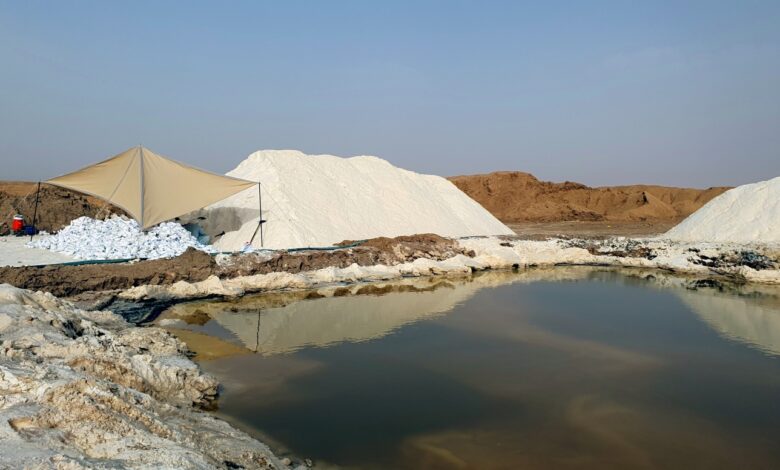Al Qasab Salt Flats in Saudi Arabia

The largest salt flats in Najd and among the biggest in the Kingdom of Saudi Arabia are the Qasab Salt Flats. They are situated in the Shaqra Governorate. The salt mines in Saudi Arabia are the country’s main salt source. They are also a popular tourist attraction. Visitors can learn about the processes of extracting and processing natural salt. Make sure you’ve reserved Cheap Umrah Packages with flights for your trip to the Qasab Salt Flats along with the Umrah Pilgrimage.
The Terrain and Background
The ancient city of Al-Qasab is known for its wheat and salt. It has been famous since before Islam. Notably noted for its poets, the city is situated 160 kilometers from Riyadh. The Al Qasab Salt Flats are amazing. Huge, flat, salt-covered areas produce raw salt. It still comes in plastic packets and is distributed all over the Kingdom. It is famous for producing 200,000 tons of salt each year. Ad Dahna Deserts’ enormous sand dunes encircle the land to the west of the salt flats. Plan a day trip to the Qasab Salt Flats if you are in Riyadh. The travel from the capital takes slightly more than an hour.
Significance of Al Qasab Salt Flats in Saudi Arabia
The Qasab Salt Flats are significant as an internal sabkha. They provide a unique model for the Al-Washem region in Saudi Arabia. The morphological features of the Qasab Salt Flats are distinct. Among them are:
- Features of aerial origin
- Features of the flood origin
- Rocky’s physical attributes

One of the internal composts in the dry climate of Saudi Arabia is the sabkha al-Qasb. It is an illustration of a phenomenon found in geomorphology. This phenomenon is the outcome of multiple climate-related factors interacting. West of Tuwaiq Mountain, in the Al-Washem region, is the salinity of Al-Qasb, which occupies an area of 33. 06 km2. Its main causes are topography, geology, climate, and an internal drainage system. The study region is divided into four terrain units. These units are:
- Leveling surfaces covered in thin layers of saline soil
- Dunes and sand beds
- Flood features
- Salted ground itself
The research area’s roads and infrastructure are seriously at risk from saline weathering. The primary source of this process is the salt crust that sits over the sabkha. Particularly in the summer, evaporation rates rise above precipitation rates. This causes more salt to precipitate. It thickens the sabkh’s salt crusts. The field investigation made clear how sabkha deposits are now being used. It showed how industry uses these deposits’ minerals and chemicals. The study also highlighted the potential advantages for the marsh habitat.
Why Al-Qasab is a Paradise for Travelers?
Al-Qasab is an ancient city known for its production of wheat and salt. It has a long-standing reputation that dates back to pre-Islamic times. It is 160 kilometers from the city. It is renowned for its poets and is situated far from Riyadh. The Ad Dahna desert’s massive dunes encircle much of the land. It’s an intriguing site to observe, as it produces raw salt.
Al-Qasab still produces around 200,000 tons of salt per year. This salt is sold in plastic packets throughout Saudi Arabia. The city has been known since ancient times for its high-quality salt. For optimal travel comfort, select Qatar Airways Flights from UK if you’re visiting Saudi Arabia. Let’s find out about its incredible tourist destinations.
· Al-Obaidi marketplace
Al-Obaidi market is the biggest and oldest of its kind in the Najd region. It is one of the best tourist destinations in Al-Qasab. It is in the city center. Visitors and retailers who sell ghee and sheep products for groceries frequent it. Auctions and product displays take place in the market’s spacious yard.

· Al-Marqab Tower
Al-Marqab Tower is east of a hill, six meters high. It is another Al-Qasab attraction that attracts lots of visitors. The tower allegedly belonged to a group of sixteen historic towers that served as a defense. The lower base of this tower stands out because it is noticeably wider than the upper sections.
· Al-Oqdah Wall
Tourists can explore the ancient Najdi cities’ walls. They can also see the old city wall, Al-Oqdah. When King Abdulaziz arrived, the locals greeted him. Some of the wall was destroyed. Still, some traces have been recovered. The three main gates of Al-Qasab are in the north (Bab Al-Burj), east (Bab Al-Mujeebib), and west (Bab Al-Houta).
· Al-Qasab Salt Flats
The salt flats, where salt is naturally extracted, are a popular tourist spot. 200000 tons are produced in the city each year. By plane with Qatar Airways travel to this amazing country.
· Al-Ekreshiya Lake
Al Ekreshiya Garden, which is 15 kilometers from Al-Qasab is 115000 square meters in size. It becomes a lovely, popular lake with great public amenities in the rainy season. Al Qasab Salts’ visit is included in many travel companies’ Umrah packages UK. So, profit from those travel deals.

· Al-Zahem House
The Al-Zahem residence is well-known. It belonged to King Abdul-Aziz’s loyal companion, Sheikh Abdullah bin Abdul Wahab Al-Zahem. Travelers should think about visiting this home. The Al-Zahem mansion is over a century old. It welcomes guests to view its antiques and photographs. Visitors can learn about the mansion’s past and current occupants.



